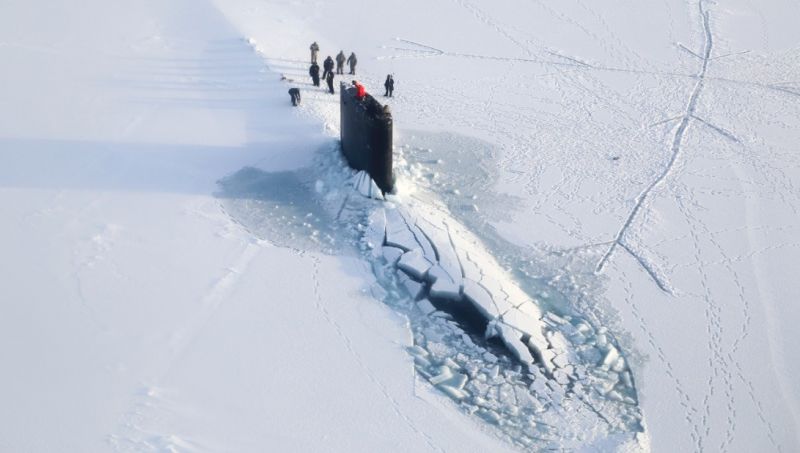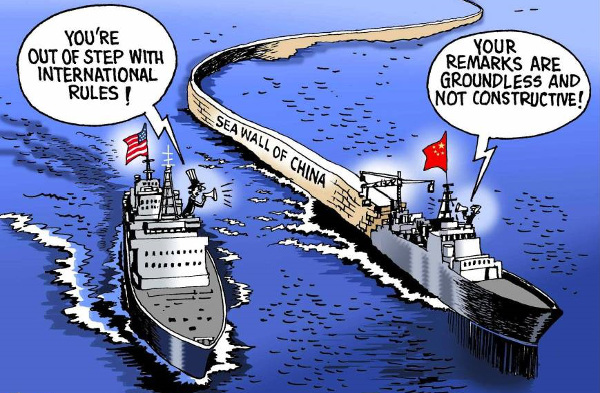The most destructive powers often come unseen, swift, and deadly. When it comes to U.S. naval power, such potent stealth is vested in the Submarine Force. Beneath the surface of the world’s oceans, out of sight of most satellite technology and traditional tracking means, U.S. subs silently pierce liquid curtains and work around the clock to project power, support allies, promote free passage in sea lanes of communication (SLOCs), and deter aggression in ways other components of the U.S. military cannot. Since the 1950s, the United States has been at the forefront of advancing undersea warfare technology and is thus considered supreme in the international playground. American attack subs, ballistic missile subs, and guided missile subs provide critical first-strike capability and nuclear maneuverability in times of crisis.
Nevertheless, the Navy’s ability to “be where it matters, when it matters” both now and in the future is in serious question. As world powers like China and Russia rapidly develop undersea capabilities and Navy submarines grow older and scarcer, America’s attainment of security goals is increasingly hampered. Analysts may soon be pressed to rescind America’s claim of undersea dominance. Indeed, undersea supremacy cannot be maintained unless the country makes increased investments in submarine technology, especially in the development of an Ohio-class sub replacement and in unmanned undersea warfare, as well as increased submarine presence. Failure to do so could result in America being strategically eclipsed under the sea.
| SLBM | Submarine-launched ballistic missile |
| SLOC | Sea lanes of communication |
| SSBN | Nuclear-powered ballistic missile submarine |
| SSBN-X | Planned class of ballistic missile submarine |
| SSGN | Nuclear-powered guided missile submarine |
| SSK | Diesel-electric powered submarine |
| SSN | Nuclear-powered attack submarine |
| USN | United States Navy |
| UUV | Unmanned undersea vehicle |
The Silent Service
On the surface, the Submarine Force appears nearly unassailable in terms of military and strategic capabilities. As of 23 September 2015, the United States Navy consists of 272 deployable battle force ships.1 These include Aircraft Carriers, destroyers, various support vessels and surface ships, and submarines. The USN Submarine Force itself is 72 ships strong, with vessels stationed in 7 different ports around the world. Each sub runs on nuclear power and is equipped with self-propelled torpedoes and some variety of missile.2 These 72 vessels are divided into three basic categories based on their design and mission goals: 54 attack subs, 14 ballistic missile subs, and 4 guided missile subs.3 Those in the first category, attack subs (SSNs), are tasked with anti-submarine warfare, reconnaissance, covert troop insertion, anti-mine operations, and various other assignments.4 5 The Los Angeles, Seawolf, and Virginia-class submarines fall under this category. Attack submarines are fast and agile, able to maneuver silently in enemy territory and create chaos for enemy fleets. Several SSNs are carry Swimmer Delivery Vehicles within external chambers called Dry Dock Shelters, also equipped with chambers called Dry Deck Shelters and Swimmer Delivery Vehicles, which work together to allow on-board Navy Seals to exit submerged submarines and make silent dashes toward land or floating targets.6
The second category is the backbone of Naval strategic deterrence and the third component of the nuclear triad: ballistic missile submarines (SSBNs). According to the U.S. Navy, SSBNs are intended to function as an undetectable launch platform for intercontinental missiles and as assurance for the precise delivery of nuclear warheads.7 The 14 Ohio-class submarines making up the SSBN force can each carry up to 24 submarine-launched ballistic missiles (SLBMs), though the New Start Treaty of 2010 reduced the number of launch ports on each SSBN by four.8 The missile most frequently carried by SSBNs is the Trident II D5 missile.2 SSBNs are specifically designed for lengthy deterrence patrols, requiring two rotating crews and 77 days at sea for every 35 spent in-port for maintenance.2 In the end, SSBNs are crucial for U.S. nuclear strategy and deterrence. Knowing that undetectable nuclear warheads could be positioned within one’s territorial waters can be an invaluable force in convincing hostile state or non-state actors to refrain from aggressive action.

The third category of undersea war craft, the guided missile submarine (SSGN), is characterized by immense firepower and Special Operations Forces abilities. When the 1994 Nuclear Posture Review declared that the Navy required four fewer SSBNs than it had at the time, the Navy responded by modifying four Ohio-class subs into undersea tanks.9 According to military statistics, the four SSGNs combined represent “more than half of the Submarine Force’s vertical launch payload capacity,” with each SSGN capable of carrying up to 154 Tomahawk land-attack cruise missiles in up to 22 missile tubes.10 Like SSNs, guided missile submarines can carry two Dry Deck Shelter to launch Special Operations Forces (up to 66 per submarine).
In the end, then, the 72 ships of the U.S. Submarine Force are powerhouses of stealth, speed, and destructive capability. The SSNs, SSBNs, and SSGNs are uniquely oriented to specific missions, though occasionally their actual operations can overlap. This provides the Navy with crucial flexibility and precision when it comes to countering external threats.
Competition from Foreign Powers
Multiple foreign states—Russia and China in particular—are concerned about the access submarines provide for U.S. power-projection operations, which can help offset an enemy’s numerical or geographic advantages. As a result, these countries are working tirelessly to eliminate the gap between their own naval abilities and those posed by American submarines.
China. According to Eastwest Institute Senior Fellow Franz-Stefan Gady, most analysts single out the Chinese navy as the “principle threat and most likely future adversary of the U.S. naval forces undersea.”11 Quiet submarines are one of the U.S. military’s most viable means of gathering intelligence and projecting power in the face of countries determined to prevent foreign military presence, such as China. This has led the Asian nation to pursue, in the words of Undersecretary of Defense for Acquisition Frank Kendall, “a suite of capabilities that are intended…to defeat the American way of doing power projection.”12 China’s attack submarine fleet consists of 57 diesel-electric boats (called SSKs) and five nuclear-powered SSNs. Of these, the more modern ones include two Shang SSNs, 12 Kilo SSKs, and 12 Yuan SSKs.13 The low number of nuclear-powered subs means that Chinese submarine fleet is right now incapable of challenging the US undersea, but China is working to develop its nuclear sub program, deploy high-tech sensors on the ocean floor, and create a network of towed sonar arrays to eliminate US subs’ advantage of stealth.14 15 The Chinese still have a long way to go to catch up with America, but it would almost certainly be a mistake to assume that they will not eventually do so if they continue their heavy investment.16
Russia. Also working to counter US submarine dominance is Russia. While the Russian Navy has been historically notorious for its low funding, high oil revenues in recent years have given Russia the opportunity to start modernizing its military. This has resulted in a 2011 increase of 150% in spending for Russia’s strategic nuclear forces, and the setting aside of $160 billion for procurement of new naval ships and submarines until 2020.17 The current Russian submarine fleet consists of 10 SSBNs, along with multiple SSGNs and several nuclear-powered SSNs. The Russian fleet also has over 20 diesel powered submarines (SSKs).17 One of their newest SSGN ships, the Severodvinsk, almost rivals America’s advanced Virginia-class ships in terms of stealth and destructive capability.18 As with China, the Russian fleet has not yet approached American capabilities; however, Russia has shown an increased willingness to reassert itself in the international sphere. Part of that resurgence involves a modernization and buildup of its undersea fleet, and while it may not amount to much now, it is gradually chipping away at America’s strategic lead under the waves.
Ultimately, the questions concerning Russian and Chinese modernization are not ones of “which country would win ship-on-ship in an undersea war with the US?”; rather, they are questions of whether the US can consistently deter aggression and support its allies both now and in the future. Right now the answer is yes; in a decade, however, all may not be so cut and dry.
A Growing Shortfall in Submarine Funding
Over the next 20 years, US submarine presence will decline far below the level necessary for achieving current security objectives. According to the Congressional Research Service’s chief naval analyst Ronald O’Rourke, the Navy needs to have 10 attack subs on deployment at any one time in order to meet the most basic defense requirements.19 To achieve this 10-ship deployment objective, the Submarine Force must maintain 48 SSNs at minimum; any fewer and there will be significant gaps in response time to global threats.20 However, the Navy’s 30-Year Shipbuilding Plan prepared by the Chief of Naval Operations and delivered to Congress (FY 2016) calls for a drastic reduction in SSN production and a complete cut of the SSGN program.
Beginning in Fiscal Year 2025, the number of attack subs will drop below the minimum of 48 and will not rise above that mark until FY2037; the deficit will bottom out in FY2029, when the Submarine Force will be seven ships below the 48-ship threshold. Even afterwards, the number of SSNs will not have reached current levels by the 2040s.21 This means that over the next few decades the Navy will be less able to maintain its current strategic presence in the world’s oceans. Vice Adm. Joseph Tofalo, Director of Undersea Warfare, calls this deficit “unfortunate”—certainly an understatement.22
In addition, the Navy plans to phase out the SSGN program over the next decade. According to the Shipbuilding Plan, the last of these “tanks under the sea” will be retired sometime during FY2028. The Navy will attempt to reduce the impact of their loss by adding extra missiles and missile tubes to future attack submarines, but this would reduce the number of submarines. Overall, it would simply amount to a Band-Aid over a bullet wound.21
The Navy considers this 30-year projection a “best case scenario” for shipbuilding at currently-projected levels of funding.21 So why this strange drop in attack submarines, particularly in light of rapid naval developments in Russia and China and the uncertainty of future global threats? It seems at first glance to indicate a lack of foresight on the Navy’s part. The answer to the SSN deficit, however, boils down to the costly Ohio-class replacement.
The SSBN-X Class
The Ohio-class SSBNs that form part of the nuclear triad are aging rapidly; the newest will turn 20 in September.23 For the US to guarantee that it can deliver nuclear warheads where necessary in the event of a nuclear attack, it needs to develop a more modern class of submarines to replace the deteriorating Ohio class, the SSBN-X. According to the 30-Year Shipbuilding plan, developing 12 SSBN-X ships to replace the 14 SSBNs is the nations “highest shipbuilding priority.”21 Thus, as they are produced, they will draw over a third of total naval shipbuilding funds, including billions of dollars that would otherwise go into making attack submarines. While critical, the SSBN-X project places our national security dominance at great risk by reducing America’s ability to effectively utilize its attack subs. Simply extending the lives of current SSNs cannot fully compensate for the reduced number of new ships being built or guarantee continued dominance over Russia and China. It truly is, as the Heritage Foundation puts it, a “glaring” and “alarming” problem.3
Conclusion
The Submarine Force is not as invincible as has long been thought; in actuality, it is at a crucial point in its development. On the one hand, the sub force is secure in its current dominance and is able to effectively achieve its strategic goals; however, its future is complicated by the necessity of juggling SSBN-X development, SSGN/SSN presence, the modernization of Russia’s and China’s fleets, and a struggling domestic economy. There are multiple courses that could be taken to ensure that American submarines are able to do their jobs well. For example, the Navy should consider extending the lives of a few SSNs by 10 years or more. This would lessen the blow caused by the 2020s and 2030s shortfall. Another option would be to add additional Virginia-class subs into the 30-year plan. This would cost approximately $2 billion per sub, but it would ensure that the Navy is using an appropriate level of new, modern ships to reach is 10-ship deployment goal.20 Yet another option would be to cut SSBN-X development; again, though, SSBNs and their nuclear weapons technology are too important to do without. Finally, the US could work to develop its unmanned undersea vehicle (UUV) program. While manned submarines require more expensive ships with life-support systems, unmanned and remotely controlled submarines are cheaper and, with advancing technology, have the potential to conduct operations similar to those of SSNs and SSGNs.24 It would take many years to reach a developed UUV program, but it could also help to reduce the submarine shortfall and lower loss of life in case of conflict.
In the end, as Eastwest Institute Senior Fellow Franz-Stefan Gady argues, “The US Navy’s dominant position in undersea warfare can no longer be taken for granted.”22 However, the “silent service” has the capability to rise above these difficulties and ensure the security of America and its allies for decades to come. The challenges are great, but solutions are present. The Navy simply has to look beneath the surface. ■
- Mark Cancian, “Is the Navy Too Small?” Center for Strategic and International Studies, 29 September 2015, http://csis.org/publication/navy-too-small.
- “Active in Commission—232,” Naval Vessel Register, http://www.nvr.navy.mil/nvrships/active/fleet.htm.
- “2016 Index of Military Strength: U.S. Navy,” Heritage Foundation, 2016, http://index.heritage.org/military/2016/assessments/us-military-power/us-navy/#fn21-14.
- Robert Farley, “US Navy Orders 10 Virginia-class Submarines at a Record Cost of 17.6 Billion,” Diplomat, 3 May 2014, http://thediplomat.com/2014/05/us-navy-orders-10-virginia-class-submarines-at-a-record-cost-of-17-6-billion/.
- “Attack Submarines—SSN,” US Navy, 12 January 2016, http://www.navy.mil/navydata/fact_display.asp?cid=4100&tid=100&ct=4.
- “Dry Deck Shelter,” Federation of American Scientists, 2 January 2000, http://fas.org/man/dod-101/sys/ship/dds.htm.
- “Fleet Ballistic Missile Submarines—SSBN,” US Navy, 12 January 2016, http://www.navy.mil/navydata/fact_display.asp?cid=4100&tid=200&ct=4.
- “Treaty Between The United States of America and the Russian Federation on Measures for the Further Reduction and Limitation of Strategic Offensive Arms (New START),” Nuclear Threat Initiative, 13 October 2015, http://www.nti.org/treaties-and-regimes/treaty-between-the-united-states-of-america-and-the-russian-federation-on-measures-for-the-further-reduction-and-limitation-of-strategic-offensive-arms/.
- “Nuclear Posture Review,” Federation of American Scientists, 1995, http://fas.org/nuke/guide/usa/doctrine/dod/95_npr.htm.
- “Guided Missile Submarines—SSGN,” US Navy, 9 November 2016, http://www.navy.mil/navydata/fact_display.asp?cid=4100&tid=300&ct=4.
- Franz Stefan-Gady, “The End of the Submarine as We Know It,” The Diplomat, 30 January 2015, http://thediplomat.com/2015/01/the-end-of-the-submarine-as-we-know-it/.
- Bill Gertz, “Pentagon Warns of Chinese Arms Dominance,” Washington Free Beacon, 28 January, 2015, http://freebeacon.com/national-security/pentagon-warns-of-chinese-arms-dominance/.
- Ben Ho Wan Beng, “The Chinese Submarine Threat,” Diplomat, 10 December 2015, http://thediplomat.com/2015/12/the-chinese-submarine-threat/.
- Robert Potter, “China’s Nuclear Submarine Distraction,” Diplomat, 1 October 2015, http://thediplomat.com/2015/10/chinas-nuclear-submarine-distraction/.
- “China: Closing the Gap in Anti-Submarine Warfare,” Stratfor, 20 July 2015, https://www.stratfor.com/analysis/china-closing-gap-anti-submarine-warfare.
- Owen Cote, Jr., “Assessing the Undersea Balance Between the U.S. and China,” Society of Scholarly Publishing, February 2011, http://web.mit.edu/ssp/publications/working_papers/Undersea%20Balance%20WP11-1.pdf.
- “Russia Submarine Capabilities,” Nuclear Threat Initiative, 10 June 2014, http://www.nti.org/analysis/articles/russia-submarine-capabilities/.
- Dave Majumdar, “The U.S. Navy’s Worst Nightmare: Super Advanced Russian Submarines,” National Interest Blog, 29 October 2015, http://nationalinterest.org/blog/the-buzz/the-us-navys-worst-nightmare-super-advanced-russian-14203.
- Ronald O’Rourke, “Navy Attack Submarine Procurement: Background and Issues for Congress,” Congressional Research Service, 22 December 2009, https://books.google.com/.
- Ronald O’Rourke, “Navy Virginia (SSN-774) Class Attack Submarine Procurement: Background and Issues for Congress,” Congressional Research Service, 17 December, 2015, https://www.fas.org/sgp/crs/weapons/RL32418.pdf.
- “Document: Navy’s 30-Year Shipbuilding Plan to Congress for Fiscal Year 2016,” US Naval Institute, 3 April 2015, http://news.usni.org/2015/04/03/document-navys-30-year-shipbuilding-plan-to-congress-for-fiscal-year-2016.
- Franz Stefan-Gady, “How Many Attack Submarines Does the United States Need?” Diplomat, 22 April 2015, http://thediplomat.com/2015/04/how-many-attack-submarines-does-the-united-states-need/.
- “USS Louisiana (SSBN 743),” Naval Vessel Register, 26 July, 2011, http://www.nvr.navy.mil/nvrships/details/SSBN743.htm.
- Ronald O’Rourke, “Unmanned Vehicles for U.S. Naval Forces: Background and Issues for Congress,” Congressional Research Service, 25 October 2006, https://www.fas.org/sgp/crs/weapons/RS21294.pdf.
Photo credit:
© Business Insider | http://www.businessinsider.com
US Submarine Surfacing Through Arctic Ice © CNN | http://i2.cdn.turner.com





